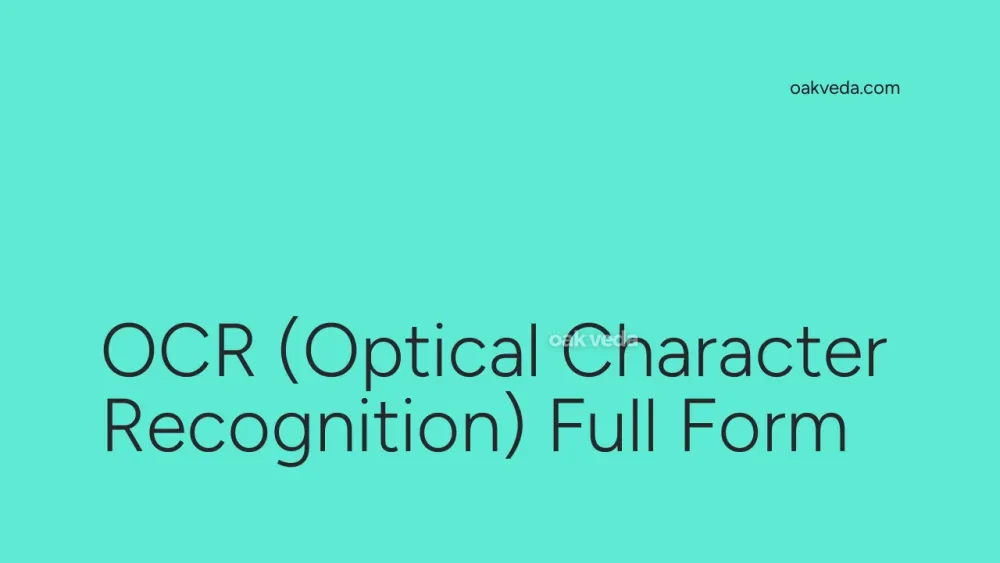
What is the Full Form of OCR?
OCR is the abbreviation for Optical Character Recognition. This technology has revolutionized the way we interact with printed and handwritten text in the digital age. OCR is a crucial component in various industries, enabling the conversion of physical documents into editable and searchable digital formats.
What is Optical Character Recognition?
Optical Character Recognition, commonly known as OCR, is a technology that enables the conversion of different types of documents, such as scanned paper documents, PDF files, or images captured by a digital camera, into editable and searchable data. OCR software can recognize and extract text from these sources, allowing users to manipulate and process the information digitally.
Origin and Development of Optical Character Recognition
The concept of OCR dates back to the early 20th century, with the first OCR systems developed in the 1940s. Initially, these systems were designed to aid the visually impaired by converting printed text into speech. Over the decades, OCR technology has evolved significantly:
- 1950s-1960s: Early OCR systems could recognize a few characters and fonts.
- 1970s-1980s: Improved algorithms allowed for recognition of multiple fonts and typewritten text.
- 1990s-2000s: Introduction of machine learning techniques enhanced accuracy and expanded language support.
- 2010s-Present: Advanced AI and deep learning algorithms have dramatically improved OCR accuracy and capabilities.
How does Optical Character Recognition work?
OCR technology operates through a series of complex steps:
- Image Acquisition: The document is scanned or photographed to create a digital image.
- Preprocessing: The image is enhanced and cleaned to improve recognition accuracy.
- Text Detection: The software identifies areas containing text within the image.
- Character Segmentation: Individual characters are isolated and extracted.
- Feature Extraction: Unique features of each character are analyzed.
- Classification: Characters are identified based on their features.
- Post-processing: The recognized text is refined and formatted.
OCR software typically uses one of two main approaches for character recognition:
- Pattern Recognition: The software compares scanned characters to stored glyph patterns.
- Feature Detection: Characters are identified based on specific features like lines, curves, and intersections.
Types of Optical Character Recognition
There are several types of OCR systems, each designed for specific applications:
- Optical Character Recognition (OCR): For printed text
- Optical Word Recognition (OWR): Processes entire words at once
- Intelligent Character Recognition (ICR): For handwritten text
- Intelligent Word Recognition (IWR): Recognizes handwritten words
- Optical Mark Recognition (OMR): Detects presence or absence of marks
Functions of Optical Character Recognition
OCR technology serves several key functions:
- Text Digitization: Converts printed or handwritten text into digital format
- Data Extraction: Extracts specific information from documents
- Indexing: Creates searchable databases of scanned documents
- Text-to-Speech: Enables reading of printed text for visually impaired users
- Language Translation: Facilitates translation of printed text into different languages
Applications of Optical Character Recognition
OCR technology finds applications in numerous fields:
- Document Management: Digitizing and organizing paper records
- Banking: Processing checks and financial documents
- Healthcare: Digitizing patient records and prescriptions
- Legal: Scanning and indexing legal documents
- Education: Converting textbooks and handwritten notes to digital format
- Automotive: License plate recognition for parking and toll systems
- Postal Services: Sorting mail based on addresses
Features of Optical Character Recognition
Modern OCR systems offer a range of advanced features:
- Multi-language Support: Recognition of text in various languages and scripts
- Layout Analysis: Preserving the original document's formatting and structure
- Adaptive Recognition: Learning and improving accuracy over time
- Cloud Integration: Processing documents remotely and storing results in the cloud
- Mobile Compatibility: OCR capabilities on smartphones and tablets
Benefits of Optical Character Recognition
OCR technology offers numerous advantages:
- Increased Efficiency: Reduces manual data entry and processing time
- Improved Accuracy: Minimizes human errors in data transcription
- Cost Reduction: Lowers expenses associated with document management
- Enhanced Searchability: Makes vast amounts of information easily accessible
- Space Saving: Reduces physical storage requirements for documents
- Improved Customer Service: Enables faster retrieval of customer information
Limitations or Challenges of Optical Character Recognition
Despite its benefits, OCR technology faces some challenges:
- Accuracy Issues: Handwritten text and complex fonts can be difficult to recognize
- Language Limitations: Some languages and scripts are more challenging to process
- Image Quality Dependency: Poor quality scans or images can affect recognition accuracy
- Processing Time: Large documents or complex layouts may require significant processing time
- Cost: High-quality OCR software can be expensive for small businesses
Future Developments in Optical Character Recognition Technology
The future of OCR technology looks promising, with several exciting developments on the horizon:
- AI and Deep Learning: Enhanced accuracy and ability to learn from corrections
- Real-time OCR: Instant text recognition in live video streams
- Handwriting Recognition: Improved accuracy for diverse handwriting styles
- 3D OCR: Recognition of text on three-dimensional objects
- Multilingual OCR: Seamless processing of documents in multiple languages
FAQs on OCR Full Form
-
What is the primary purpose of OCR technology? OCR technology primarily converts images of text into machine-readable text data.
-
Can OCR recognize handwritten text? Yes, advanced OCR systems can recognize handwritten text, although with varying degrees of accuracy depending on the clarity of the handwriting.
-
Is OCR 100% accurate? While OCR technology has improved significantly, it is not 100% accurate. Factors like image quality, font complexity, and language can affect accuracy.
-
Can OCR work with multiple languages? Yes, many OCR systems support multiple languages and scripts.
-
How can businesses benefit from OCR technology? Businesses can use OCR to digitize documents, automate data entry, improve searchability of records, and enhance overall efficiency in document management.
You may be interested in:
- GPRS (General Packet Radio Service) Full Form
- ITI (Industrial Training Institute): Full Form Explained
- BCG (Bacillus Calmette-Guérin): Full Form and Importance
- SLR (Full Form): Statutory Liquidity Ratio & Single Lens Reflex
- ERP (Enterprise Resource Planning)
- CTBT (Comprehensive Nuclear-Test-Ban Treaty)

